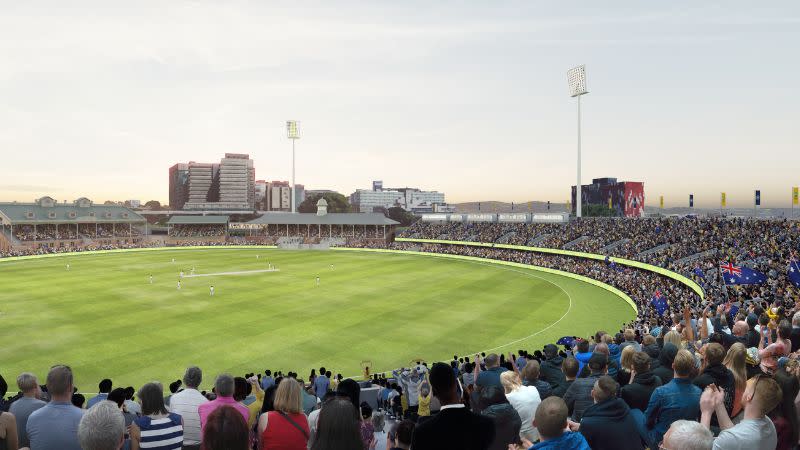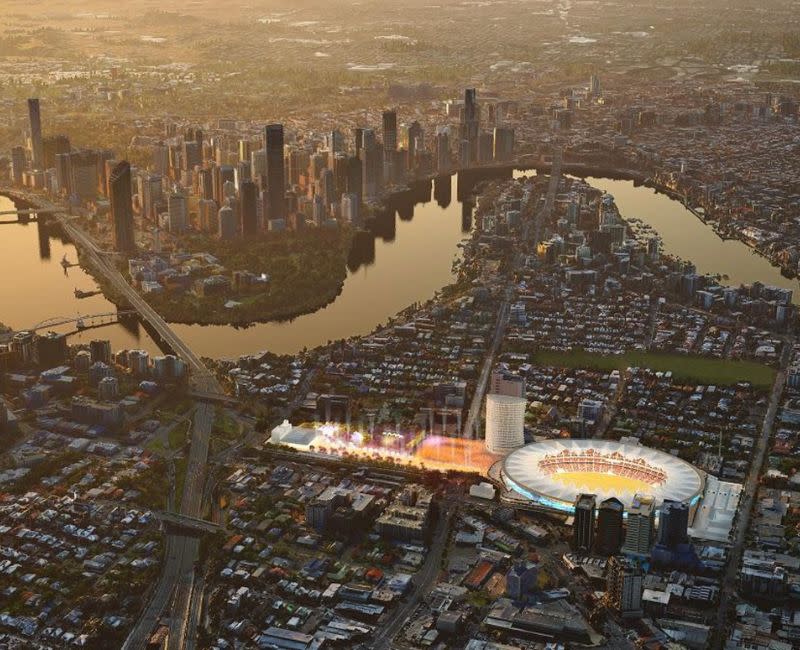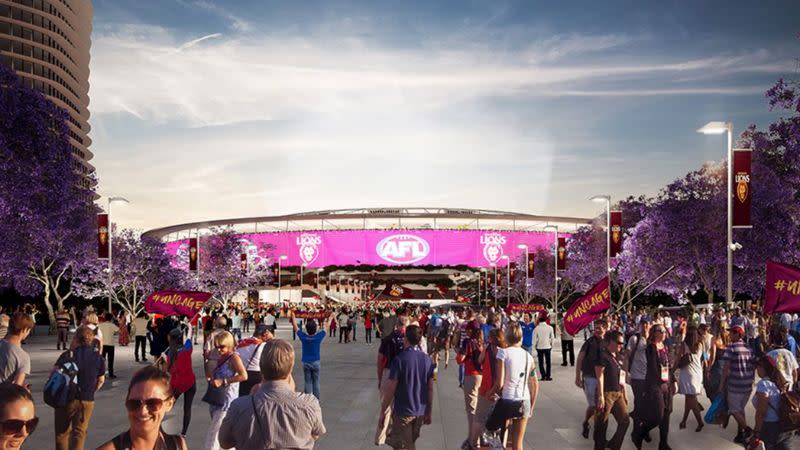‘Mini-Gabba’ Plan Unveiled for Brisbane RNA Showgrounds

Almost a century after the last baggy green-capped gladiator took to its long overgrown pitch, the Australian cricket team is destined to wield the willow again where Sir Donald Bradman made his Test debut.
Well, that’s the plan anway.
On Friday, the Queensland government unveiled a $137-million proposal to transform the verdant pastures of the Brisbane RNA Showgrounds’ main arena into a 20,000-seat ‘mini-Gabba’.
It would be a temporary replacement for the city's hallowed stadium at Woolloongabba while it is undergoes a $2.7-billion redevelopment for the Brisbane 2032 Olympics.
During the past decade, inner-city Bowen Hills and the RNA Showgrounds have been the focus of one of Brisbane's largest urban renewal strategies since the post-World Expo ’88 development of South Bank.
The $2.9-billion regeneration of the 22ha heritage showgrounds precinct—owned and operated by the Royal National Agricultural and Industrial Association—being undetrtaken in partnership with Lendlease, comprises 340,000sq m of new residential, commercial and retail buildings.
Among the works completed so far is the benchmark 10-storey 25 King, Australia’s tallest engineered timber office building.
The precinct is also home to a historic landmark for Queensland's development industry—the Ernest Baynes Stand, built in 1922-23 and one of the earliest major projects undertaken by the then fledgling Hutchinson Builders.
Under the latest plans, the showgrounds’ main arena would be upgraded to enable it to host AFL and cricket fixtures from 2026 until the redevelopment of The Gabba—the city’s storied cricket field and home of Queensland Cricket, Brisbane Heat and the AFL's Brisbane Lions—is completed.
“An extensive southeast Queensland-wide review has identified the RNA Showgrounds’ main arena as the best possible temporary venue during The Gabba rebuild,” a government statement said.
The arena's revamp would not only deliver “a lasting community legacy” but also an “historic homecoming for cricket” in Brisbane, it added.

Better known these days as the venue for the city’s annual agricultural exhibition—affectionately dubbed the Ekka—it is where Queensland’s first international Test was played, in 1928-29.
That year, Sir Donald Bradman—one of the sport’s greatest batsmen—walked onto the Brisbane field in his maiden appearance for Australia against England, etching it into sporting history.
But its days as the city’s premier cricket ground were short-lived.
Only two Tests and a couple of dozen first-class matches were played before the Queensland Cricket Association moved across the Brisbane River to The Gabba.
Queensland Sport Minister Stirling Hinchliffe said the unveiling of the plans for the arena upgrade had come after “several months of consultation” with cricket and AFL administrators.
“We believe that an upgraded main arena at Brisbane’s RNA Showgrounds is the best possible and most cost effective option for the relocation of the AFL, cricket and other major events during The Gabba’s redevelopment,” he said.
“The Ekka is an absolute Queensland institution and absolute Brisbane institution.
“We think it’s important that we see this location, that brings the city and country together, get looked after and use that as an opportunity to provide this platform for the displacement.”
He also pointed out that the Brisbane Lions’ contribution to Brisbane’s visitor economy was estimated at $80 million a year.

A key part of the Ekka show ring upgrade is the development of a permanent seating bowl below a temporary grandstand at Machinery Hill around the northern end of the ground.
After the Olympics, it is proposed the arena be scaled back to a 12,000-seat capacity.
Up to $45.7 million has been committed by the Queensland government to the arena revamp while the Brisbane City Council, RNA and The Gabba’s primary tenants—Queensland Cricket and the Brisbane Lions—have been asked to stump up the remaining $91 million.
Work must begin next year so the arena is ready for the 2025-26 cricket season and scheduled start of The Gabba redevelopment, which will increase its capacity from 42,000 to 50,000 spectators.
Hinchcliffe said he had written to Brisbane Lord Mayor Adrian Schrinner asking for “a significant contribution” to the cost of the project.
“This is the beginning of the negotiation that we need to have,” he said.
But Cr Schrinner has slammed the request as a “ridiculous amount of money the state is trying to extort from Brisbane ratepayers ... to help cover their Gabba blowout”.
“It was the state government’s decision to tear down the Gabba so it’s the state government’s responsibility to find the Brisbane Lions and Heat a temporary home,”
“This half-baked announcement by the state is precisely why we need an independent infrastructure authority making decisions about the Brisbane 2032 Olympic and Paralympic Games.
“I’m pleased the state has finally recognised that Brisbane teams should keep playing in Brisbane while the Gabba is redeveloped.
“However, Lions and Heat fans will rightly be angry the state’s failure to make a proper funding commitment to this temporary stadium risks leaving their teams without a home.”

Hinchcliffe said he had attempted to contact the Lord Mayor the day before the plans were unveiled but he had “refused to respond”.
“This is something that needs to have a number of parties being involved,” he said. “So all those parties were advised of this starting point for negotiations at the same time.
“I contacted the Lord Mayor ... made it clear that it was an important matter and [there was] no return of call.
“It became clear from the response from his office that there was going to be no further conversation between myself and the Lord Mayor immediately.”
On Sunday—in protest of what he described as “a dysfunctional farce, a pointless talkfest”—Cr Schrinner resigned from the Brisbane 2032 Olympic and Paralympic Games intergovernmental leaders’ forum.
“I will no longer fall into line and support the state government’s current Gabba plan,” he said. “The State Government’s ham-fisted and foolish attempt to extort Brisbane ratepayers for tens of millions of dollars for a new RNA stadium was the final straw.”
He added that he had no doubt there were better options than demolishing and rebuilding The Gabba but “the state government has never genuinely looked for them”.
“The Games are a once-in-a-lifetime opportunity for Brisbane and Queensland. But unless the state government’s approach changes, this opportunity will be squandered through mismanagement.
“I believe that the government has completely lost its way,” Cr Schrinner said.
Let the games begin.














